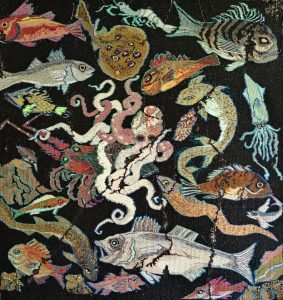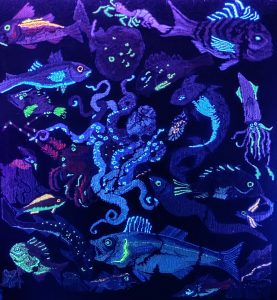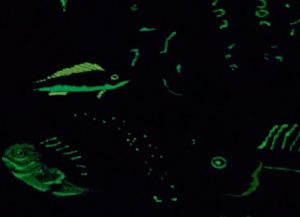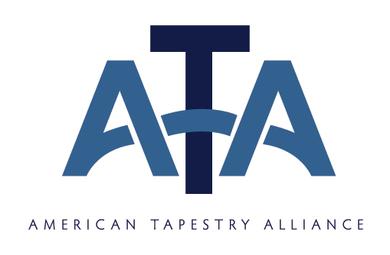
Alta Turner
Pompeii Reconstructed: LED, 2024
36 in x 36 in

Alta Turner
Pompeii Reconstructed: Blacklight, 2024
36 in x 36 in
Alta Turner’s Artist Statement
A long-time fixation on a Pompeii mosaic, Marine Life in the House of Faun begged for reconstruction in a different medium, a different time. Originally pieced in 2nd century BCE, buried in ash by Vesuvius’ 79 CE eruption and initially excavated 1831 by Carlo Bonucci, the piece celebrates Mediterranean beauties and gastronomic pleasures.
Loving strings has led more recently to exploring characteristics and effects of fluorescent threads. It is enlightening – pun very much intended – that, viewed with different light sources, a singular woven object evokes remarkably differing responses. Enlightening? Yes . . also calming – that while the same coldly-real object reveals differentially, it remains unchanged. Or does it? Pompeii Reconstructed is the most recent work, revitalizing the 2100+ years old mosaic, reconstituted here, by:
- Playing differential effects of natural, metallic and fluorescent wefts viewed with 3 light sources: LED versus black light versus ‘afterglow’ following black light exposure. Viewsofrendered creatures differ strikingly – toggling between stilled-life and subsurface living;
- Giving a nod to wabi-sabi, an ~16th century Japanese aesthetic that celebrates impermanence [retrieved mosaic’s cracks and missing tesserae, mimicked with exposed warps], incompleteness [extending unfinished creatures passing through the border]; and, imperfection [inevitable – de facto of life, living and art];
- & Documenting human degradation to the erstwhile bountiful Mediterranean resource, laying red crosses onto species classified by conservation commission|agencies as overfished, endangered or extinct.

Alta Turner
Pompeii Reconstructed: Afterglow, 2024
Detail, 6 in x 6 in
Alta Turner’s Biography
Undergraduate training in fine arts and art history, followed by graduate work in environmental studies and statistics led to 36 years of statistical consulting with post-retirement focus on tapestry building. In 1997, after study of various loom-controlled weaving techniques, the greater narrative history and freer potentials of tapestry building appealed. The potential to capture time in the process has driven narrative content, revealing layers previously not considered.
